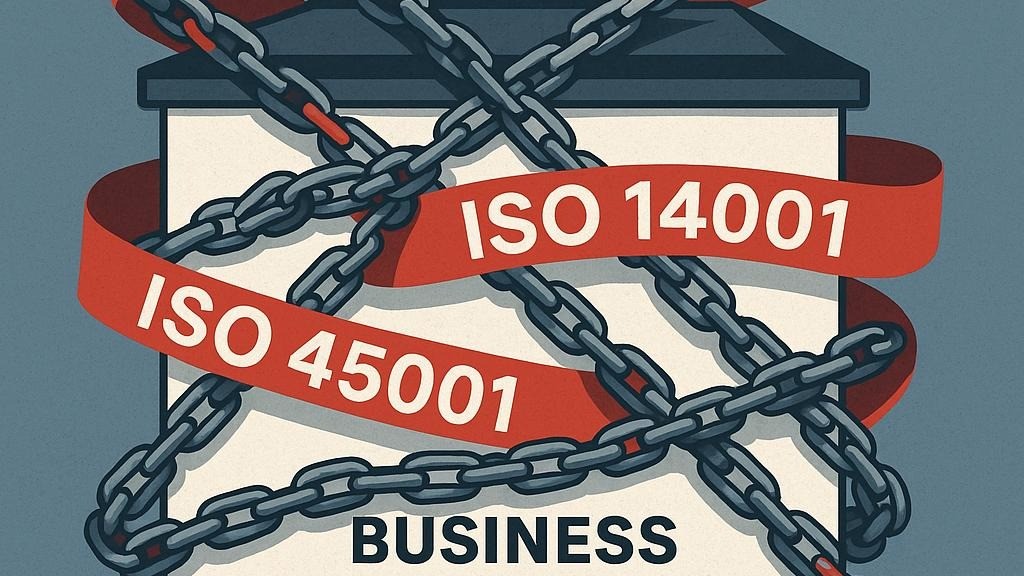When most business owners or management hear the term ISO standards, they think of credibility, consistency, and a structured path toward operational excellence. And that's true—done right, ISO standards and becoming certified to one or more of them, can help a business demonstrate reliability, improve efficiency, and build trust with their customers.
But here's the uncomfortable truth: what most companies do during that journey, and especially after becoming compliant is turn ISO into a trap of their own making.
Instead of leveraging their chosen ISO standard as a framework for continual improvement, they reduce it to a bureaucratic checklist, a set of documents which dictate but don't educate or facilitate, a system of shalls and shall nots without the scope for considering the why and why not.
The result?
Red tape grows, innovation shrinks, and the business slowly suffocates.
The Misconception: ISO as the Path
A common mistake is treating ISO certification as the ultimate goal—the path itself.
Business owners often set out with the goal or instruct their teams to "get ISO certified" as though the piece of paper on the wall is the win.
When the standard becomes an idol, the organization starts doing work that satisfies auditors rather than customers.
- Procedures become more about passing an audit than solving real problems.
- Employees start following processes blindly, even when they no longer make sense.
- Change feels risky, because any deviation could be "non-compliant."
In effect, the company builds a fortress of documentation and red tape that keeps out creativity and improvement.
What ISO Really Is: The Guardrail
ISO standards were never meant to be the path.
They are guardrails.
The frameworks exist to prevent catastrophic failures—poor quality, lack of traceability, unsafe environments—not to prescribe every step of how you should run your business. ISO standards are written to apply to all, but not to be viewed as a one size fits all.
Think of driving: guardrails keep you from plunging off a cliff, but you still need to steer, accelerate, and navigate the road ahead. If you only stare at the guardrails, you'll crash anyway. How you drive also depends on what vehicle you're driving, the time of day, weather, with each factor needing to be considered long before any thought of the protection the guardrail provides.
The real intent of ISO standards is to foster a culture of continuous improvement, safety first and ensure negative impacts are reduced. Done right, they give you structure to learn from mistakes, adapt processes, and deliver better value.
The Danger of Red Tape
When businesses misinterpret ISO, they create dangerous side effects:
- Stifled innovation: Teams avoid experimenting with new ways of working because it "might not be ISO compliant."
- Employee disengagement: Staff see processes as pointless hoops to jump through rather than tools that make their jobs easier.
- Customer neglect: Resources shift toward pleasing auditors instead of solving customers' problems.
- False security: Leaders think, "We're ISO certified, so we must be good," even as service quality declines.
Ironically, these problems contradict the very spirit of ISO standards, which are supposed to encourage adaptability and customer focus.
How to Keep ISO from Killing Your Business
-
Shift the mindset
Stop saying "we need to be ISO compliant" and start saying "we need to improve continuously." Compliance will follow.
What does the standard say? Now how do we interpret this for whats right for us. Don't get me wrong, were not advocating for negating requirements or feeling they are too burdensome so we wont apply them to our business because they aren't relevant. That's the wrong mindset.
What i am saying though is Ask first and apply later. What is the risk in my business? Who is at risk and how? What are the deficiencies this requirement is looking to resolve and mitigate, and how will that make me better. How could i demonstrate that in my business and why am i convinced that is the right thing to do to meet both my business needs and those of the standard.
-
Audit for value, not just paperwork
Ask, "Is this process still adding value for the customer?" not just, "Will the auditor accept it?"
If you're still auditing the same procedures every year, stop it. The standard doesn't dictate the timeframe. If you're still using checklists, stop it! Checklists don't work, unless they're well thought through and most aren't. If your auditors are only in senior positions, then its time for a change. Often the best ones to ask the questions of why is this done this way, are those that have never been involved in the process at all. If you cant remember the last time you had an internal or external NCR was, someones definitely not doing their job well enough.
-
Empower employees
Give teams permission to adapt processes and improve them within the ISO framework.
Allow employees at all levels to challenge the status quo. Why do we do what we do and how does it make us better? Because the standard says so? Does it really, or is that just an interpretation? Don't allow auditors to dictate how you comply, they're not supposed to consult anyway, and should be looking for how what you do meets the expectation of the standard, not telling you how to do it.
-
See ISO as a baseline, not the finish line
Certification should be proof of a system that works, not the system itself. Don't rely on your external audits to show how good you are, be better yourself.
Conclusion
ISO standards can be a powerful enabler of excellence, but only if business owners and management treat them as guardrails.
The real path forward is improvement, innovation, and customer focus. If a business mistakes ISO for the destination, it risks becoming a bureaucratic shell—compliant on paper, irrelevant in practice.
Don't let red tape strangle your business.
Use ISO for what it was meant to be: a framework that supports and ensures the quality of your products and services, a safe and positively impactful environment and infrastructure plus much much more.
Focus on what really matters—delivering better outcomes every day.




.png)
